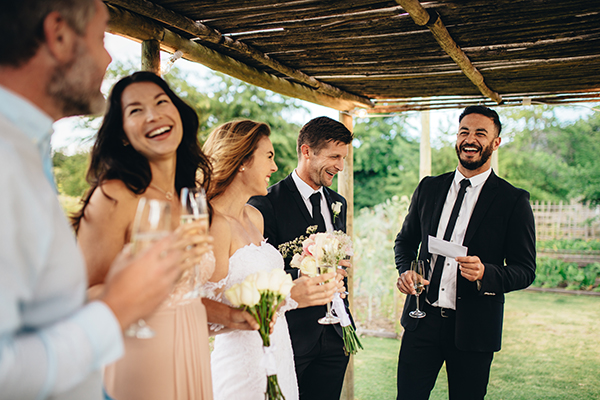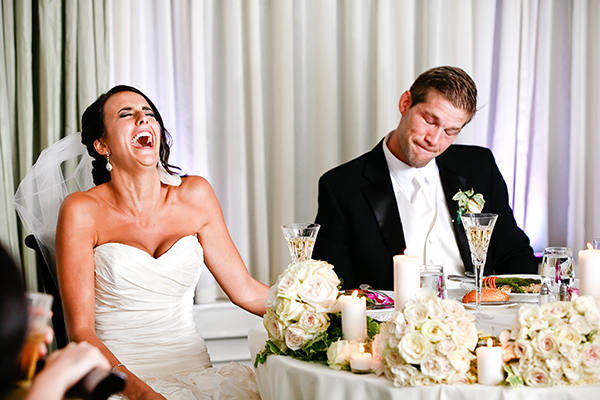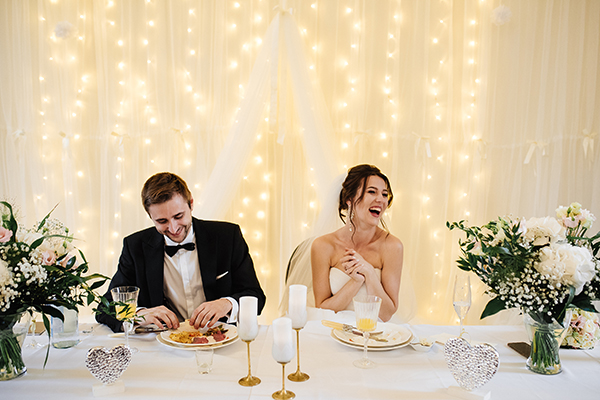Perfect Your Wedding Speech with 12 Simple Steps
Toast to your wedding with simple 12 steps
We asked Jackie Graybill, from Toastmasters International, what her tips are to perfecting a speech, you can intergrate these 12 easy to navigate tips into your wedding speech, so you're at the top of your class during the 'I Do's'.
Stories work in speeches in many contexts, but they are at the heart of a good wedding speech, stories are a part of our DNA as humans. We are drawn to them. We can’t get enough of them.
So, if you want to engage your audience instead of putting them to sleep, if you’d like to keep their interest so much so that they forget about their smartphones, story is the vehicle to drive your speech there, and to keep your audience experiencing an unforgettable ride.
How can you spice up your storytelling and ramp up your skills? Practice using the following as you hone your stories and watch for the delightful effect on family and friends at the wedding!
1. Practice retelling scenes

As you retell memorable scenes from films or TV, you will practice dialogue and start to pick up storytelling techniques. This include what elements are best to include and which are unnecessary and don’t drive the action forward, thus slowing down the pace.
2. Start in the action
If you begin in the action and give just enough context to keep your audience from becoming confused, you’ll pique the interest of your listeners. Remember, just like a Hollywood film, you can jump back and forth in time with your story. Start with a dramatic scene and go back to fill in the details. Or try using something like, “later, I would look back on this moment as ____,” filling in the blank with your own appropriate sentiment.
3. Mystery

Beginning with a mystery and peppering more mysteries throughout your story creates intrigue, as your listeners want to know what happens and begin guessing at the answer in their own minds. A great start is with something like, “Let me make a confession...”
4. Create a loop, or multiple loops
This is the technique of leaving a mystery unsolved before you introduce another one. You can even leave a loop open until the end and give your audience the satisfaction of solving the mystery at the end. Just remember to eventually close the loop.
5. Leave them wanting more

Do your best to cut out any non-pertinent details that don’t set up your story or drive the action forward. If you feel like you might be adding too much detail to a specific aspect of your story, you probably are.
6. Analogy/Metaphor
Using analogies, metaphors, similes can bring humour and interest to your stories. For example, describing when he was looked at by a bear comedian Jim Gaffigan said, “I was sunburned so I probably looked like a giant land salmon.” https://www.youtube.com/watchv=DPQklphWxK0
7. Voices and accents
Experiment with dialects, vocal range differences of high or low, raspy, or clear, different ages, louder or softer voices, whispers, slower drawls… the only limit is your own creativity!
8. The power of dialogue

Instead of just telling us what your characters have said, become those characters as they have a dialogue with each other. You can utilise the spatial physicality of characters as they talk with each other by shifting slightly where you stand and where you are looking.
9. The power of the pause
When speaking, a second can feel like ten, and ten seconds can feel like a minute. Accordingly, pausing can feel unnatural and uncomfortable, but it can also be a welcome gift to your audience, as it gives them time to absorb what you have said. Pauses can also be used to emphasise information, phrases or words in a powerful way.
10. Follow the PIXAR formula

The PIXAR story formula, made popular by the elements contained in PIXAR films, is as follows:
Once upon a time
Every day
But one day
Because of that
Because of that (add additional “because of that”s as necessary)
Until finally
Ever since then
Practice your stories according to these elements, and you might be surprised to find out how many effective stories follow this formula. http://thescientistvideographer.com/wordpress/the-pixar-storytelling-formula/
11. Engage the senses
Our five senses have a powerful effect on our human experiences and when any of them are evoked, this can trigger audience members in powerful ways. To practice this skill, take someone on a sensory walk. This could be a description of a delicious recipe you made, a nature walk, or anything that includes multiple of the five senses. Just be careful with this powerful story element, as there are some things you may not want to bring up with your listeners (insert dog poop and other cringeworthy sensorial triggers).
12. Practice in your everyday life

“How was your day?” Can turn into, “you wouldn’t believe what happened today!” followed by an interesting story.
Enjoy the preparation and giving your speech at the wedding. A good speech will leave your audience reminiscing as your stories remind them of other stories.
ABOUT THE AUTHOR
Jackie Graybill is a member of Toastmasters International, a not-for-profit organisation that has provided communication and leadership skills since 1924 through a worldwide network of clubs. There are more than 400 clubs and 10,000 members in the UK and Ireland. Members follow a structured educational programme to gain skills and confidence in public and impromptu speaking, chairing meetings and time management. To find your nearest club, visit www.toastmasters.org
Subscribe to our newsletter
For the latest news, magazine releases, trends, inspiration, wedding planning tips and exciting launches delivered straight to your inbox!









